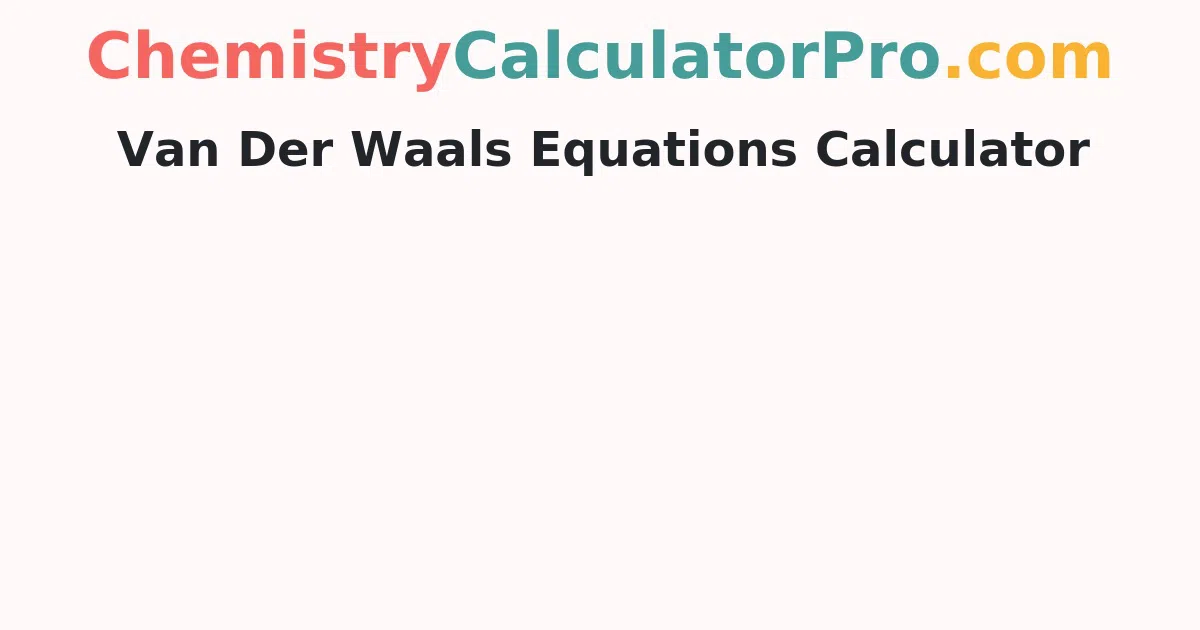Van Der Waals Equations Calculator
The Van Der Waals Equation Calculator is a free online tool for calculating the physical properties of gases. The computation is faster, and the physical properties are displayed in a fraction of a second using this online calculator tool.
Real vs Ideal gas
An ideal gas comprises many randomly moving point particles that can collide with one another and the container's walls. It's a kinetic molecular theory, which we've discussed in detail in our thermal energy calculator. You might also be interested in our particle velocity calculator, which calculates the average particle velocity at a particular temperature.
The natural gas law, which is a variation of the ideal gas law, considers two extra factors:
- Molecules can not only collide with one other as they would in an ideal gas, but they can also attract each other within a few molecule radii. Because the container's surface is devoid of gas particles, molecules at the surface are drawn into the substance. As a result, the natural compressed gasses on the container walls are lower than the ideal gas.
- Molecules are non-zero volume particles, not material points like in an ideal gas. As a result, the volume of a full gas cannot be smaller than a fixed value.
Van Der Waals Constant
Van der Waals constants are substance-specific constants that may be derived using critical point parameters, including pressure, temperature, and molar volume. A substance's liquid and gas phases have the same density at a critical point, making them indistinguishable. Critical point parameters have a good relationship
8 * p * V = 3 * R * T where R is the gas constant R = 8.3144598 J / (mol * K)
One of the van der Waals constants in the actual gas law is attraction parameter a, which accounts for the fact that particles can attract one another, and the other is repulsion parameter b, which is the effectivexisting, our van der Waals equation calculator uses the following formulas
a = 3 * pc * Vc² and b = Vc / 3
The van der Waals equation of state passes into the ideal gas equation if the interaction between molecules (a = 0) and the size of the molecules (b = 0) can be ignored.
If you would like to learn more about the other chemical calculator that gives instant results, stay tuned to Chemistrycalc.Com
How to use Van Der Waals Equation Calculator?
The following steps will guide you through using the Van der Waals equation calculator
- Fill in the input fields with the volume, temperature, number of moles, and particle attraction measure.
- To calculate the optimal gas pressure, click the "Calculate Pressure" option.
- The ideal gas pressure will be displayed in the output field using the Van der Waals equation in the output field.
Van Der Waals Equation of State
There are two elements to our van der Waals equation calculator. To estimate van der Waals constants, you must first provide the crucial parameters of the considered gas. In advanced mode, you can alter those constants directly or select one of the common gases.
With the following relationship, you may learn what is the relationship between volume, pressure, and temperature in real gas in the second section of the van der Waals equation calculator
(p + a * (n / V)²) * (V / n - b) = R * T
- The pressure of a gas is denoted by p
- The volume of a gas is V
- The temperature of a gas is denoted by T
- The number of moles of gas is n.
- The gas constant is R. R = 8.3144598 J / (mol * K)
The volume of one mole of molecules corresponds to the constant b value (it is a correction for finite molecular size). As a result, we must apply the constraint V / n > b to avoid a situation in which the volume of the molecules exceeds that of the entire gas.
The van der Waals equation is an excellent approximation of the genuine gas state equation in most cases, especially at high pressures and around the gas condensation parameters in temperature and pressure.
FAQ’s on Van Der Waals Equation Calculator
1. What are the drawbacks of using the van der Waals equation?
Van der Waal's equation has some limitations.
- The value of 'b' fluctuates with pressure and temperature and is not constant.
- In certain circumstances, the value of is equal to 3b, whereas in other cases, it is equivalent to 2b.
- For most gases, the value of is not equal to, but it is usually greater than 3.
2. Why does the van der Waals equation provide a more accurate representation of real-world gas behaviour?
By accounting for the volume of the gas molecules as well as the attractive forces that exist between them, the van der Waals equation improves on the ideal gas law.
